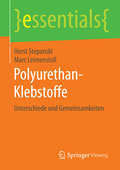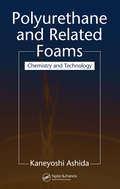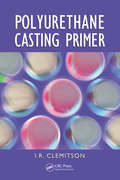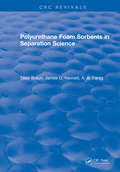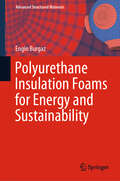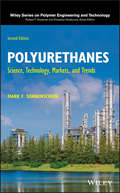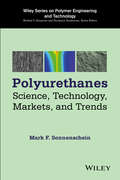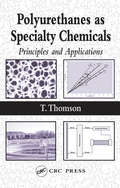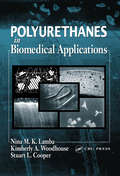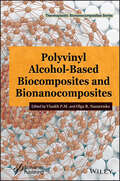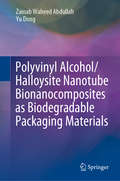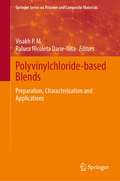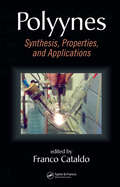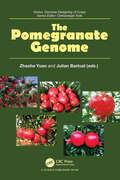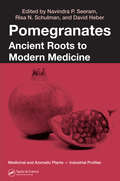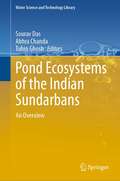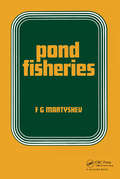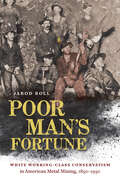- Table View
- List View
Polyurethan-Klebstoffe: Unterschiede und Gemeinsamkeiten (essentials)
by Horst Stepanski Marc LeimenstollDie Autoren zeigen anschaulich dieunterschiedlichen chemischen Zusammensetzungen der verschiedenen Arten vonPolyurethan-Klebstoffen und welche Gemeinsamkeiten diese andererseits haben. Dadurchmöchten die Autoren mehr Verständnis für die Breite der Möglichkeiten wecken,die der reich bestückte Baukasten der Polyurethan-Chemie denKlebstoff-Formulierern bietet. Dies erleichtert angesichts sich wandelndertechnologischer Anforderungen die Kommunikation zwischen Klebstoffanwendern und-herstellern.
Polyurethane and Related Foams: Chemistry and Technology
by Kaneyoshi AshidaPolyurethane and Related Foams: Chemistry and Technology is an in-depth examination of the current preparation, processing, and applications of polyurethanes (PURs) and other polymer foams. Drawing attention to novel raw materials, alternative blowing agents, and new processing methods, the book accentuates recent innovations that meet incre
Polyurethane Casting Primer
by I.R. ClemitsonOmitting complicated chemistry concepts, Polyurethane Casting Primer presents practical details on the casting of polyurethane products to assist readers in their daily work. It covers fundamental methods, explores hands-on design and production topics, and keeps theory to a minimum.The book fully explains casting and allied processes. Starting fro
Polyurethane Foam Sorbents in Separation Science
by BraunThe purpose of this book is to present in a monographic and systematised form a review of all the literature devoted to polyurethane-based polymeric sorbents in separation chemistry. The primary types of sorbents dealt with are polyurethane foams and open-pore polyurethanes. The structure of the monograph follows this dichotomy. A book of this nature should stimulate thinking and incite its reader to consult the original literature. It will, however, not make such a consultation superfluous. A fair amount of the results described in this monograph constitute the main activity of investigation which took place in the authors laboratories during the past decade.
Polyurethane Immobilization of Cells and Biomolecules: Medical and Environmental Applications
by T. ThomsonThis book provides a comprehensive review of the chemistry and research illustrating the benefits of polyurethane for immobilizing cells, with dozens of case studies in medical devices and environmental engineering.• Offers an essential resource for medical and environmental scientists• Provides a multidisciplinary and lucid writing style that uses little or no jargon• Extrapolates current technology into advanced areas, especially environmental remediation and medical devices• Fills the gap between immobilization research and practical applications
Polyurethane Insulation Foams for Energy and Sustainability (Advanced Structured Materials #111)
by Engin BurgazThis review book focuses on the structure-property relationships of polyurethane nanocomposite foams in comparison with those of conventional polyurethane composite foams. The thermal insulation properties of polyurethane foam nanocomposites are discussed along with other traits such as their morphology, mechanical and thermomechanical properties, thermal degradation and flammability, energy absorption and saving capability, recycling and recovery behavior. In turn, the book discusses potential applications of PU nanocomposite foams and outlines the main problems that remain to be solved with regard to this important topic.
Polyurethane Sealants: Technology & Applications
by Robert M. EvansPolyurethane sealants are used in many high-volume applications such as construction and automotive. This volume provides an in-depth, illustrated survey of both the technology and applications. The detailed information will be useful to all those involved in the research, development, processing, evaluation and use of sealants for high-volume applications.
Polyurethane Shape Memory Polymers
by W.M. Huang Bin Yang Yong Qing FuShape memory polymers (SMPs) are some of the most important and valuable engineering materials developed in the last 25 years. These fascinating materials demonstrate remarkably versatile properties-including capacity for actuation and stimulus responsiveness-that are enabling technologists to develop applications used to explore everything from th
Polyurethanes: Science, Technology, Markets, and Trends (Wiley Series on Polymer Engineering and Technology)
by Mark F. SonnenscheinThis book, cohesively written by an expert author with supreme breadth and depth of perspective on polyurethanes, provides a comprehensive overview of all aspects of the science and technology on one of the most commonly produced plastics. Covers the applications, manufacture, and markets for polyurethanes, and discusses analytical methods, reaction mechanisms, morphology, and synthetic routes Provides an up-to-date view of the current markets and trend analysis based on patent activity and updates chapters to include new research Includes two new chapters on PU recycling and PU hybrids, covering the opportunities and challenges in both
Polyurethanes
by Mark F. SonnenscheinA complete overview of a key plasticOne of the most versatile polymer materials, polyurethanes have a unique chemical nature that allows for shaping and molding to fit all sorts of consumer and industrial products - seat cushions, carpets, insulation, coatings, and refrigerators to name a few. Despite its popular uses, polyurethane science has only relatively recently achieved appreciation for the richness of its expression as a polymer family. This book provides a thorough presentation of polyurethane science, technology markets and trend analysis based on recent patents. Although it does not provide ultimate detail (such as explicit information typically in patents), the book has a flow and continuity that allows readers to find all the background necessary to understand any other more detailed polyurethane information found elsewhere.Anyone involved in the polymer and plastics industry will find this book a key resource with features that include:An in-depth summary of the current state of polyurethane research and knowledgeDiscussion of the applications, manufacture, and markets for polyurethanesAnalytical methods, reaction mechanisms, morphology, theoretical techniques, and the selection of chain extendersPolyurethane flexible and rigid foams, elastomers, coatings, adhesives, and medical applicationsIn-depth coverage of governmental regulations, non-isocyanate/non-phosgene routes to polyurethane structure, and industrial routes to environmental, health, and safety risk mitigation
Polyurethanes as Specialty Chemicals: Principles and Applications
by Timothy ThomsonLooking beyond the traditional applications of polyurethanes (PUR), Polyurethanes as Specialty Chemicals presents a different approach to polyurethane chemistry by examining a range of new products and new research for both environmental and medical applications. This book is also the first in its field to provide useful design tools for product de
Polyurethanes in Biomedical Applications
by NinaM.K. LambaPolyurethanes in Biomedical Applications studies the use of polyurethanes in implanted medical devices. This analysis describes the concepts of polymer science, the manufacture of polyurethanes, and the biological responses to implant polyurethanes, reflecting the developments in biomaterials science and the interdisciplinary nature of bioengineering.
Polyvinyl Alcohol-Based Biocomposites and Bionanocomposites
by Visakh P. M. Olga B. NazarenkoPolyvinyl Alcohol-Based Biocomposites and Bionanocomposites Serves as a one-stop reference resource for important research accomplishments in the area of polyvinyl alcohol-based biocomposites and bionanocomposites. Many recent research accomplishments in the area of polyvinyl alcohol (PVA)-based biocomposites and bionanocomposites are summarized in this book. In it, the editors discuss as many topics as possible on the most recent state-of-the-art developments regarding these biocomposites and bionanocomposites, the challenges faced when using them, and their future prospects. In addition to providing a biodegradation study of them, their significance and applications are also discussed, along with practical steps toward their commercialization. Moreover, PVA/cellulose-based and PVA/starch-based biocomposites and bionanocomposites are discussed, along with the biomedical applications of PVA-based composites and nanocomposites, and PVA-based hybrid interpolymeric complexes and their applications. Audience This book will be a very valuable reference source for polymer researchers, materials scientists, biochemists, engineers, graduate and postgraduate students working on polymers, composites, and nanocomposites, especially in the area of polyvinyl alcohol-based bionanocomposites.
Polyvinyl Alcohol/Halloysite Nanotube Bionanocomposites as Biodegradable Packaging Materials
by Zainab Waheed Abdullah Yu DongThis book focuses on the preparation and characterisation of polyvinyl alcohol (PVA)/ halloysite nanotube (HNT) bionanocomposite films with different HNT contents for potential use in food packaging. It examines the effect of material composition and nanofiller content on mechanical, thermal and optical properties in relation to their morphological structures, and also comprehensively describes the water resistance, biodegradation and migration rates of such bionanocomposites, as well as their barrier properties in terms of water vapour transmission, and water vapour, air and oxygen permeabilities. Further, this book discusses the use of Nielsen model and Cussler model to predict the relative permeability of bionanocomposites, demonstrating that Nielsen model is more effective and in better agreement with experimental data obtained. Lastly, it discusses the application of bionanocomposite films in food packaging to prolong the shelf life of freshly cut avocados and peaches.
Polyvinylchloride-based Blends: Preparation, Characterization and Applications (Springer Series on Polymer and Composite Materials)
by Visakh P. M. Raluca Nicoleta Darie-NitaThis book summarizes many of the recent research accomplishments in the area of polyvinylchloride (PVC)-based blends and their preparation, characterization and applications. Various sub-topics are addressed, such as the state-of-the-art of PVC based blends, new challenges and opportunities, emphasis being given to the types and sizes of components/fillers and optimum compositions of PVC blends, their processing and structure-properties relationships, modification/compatibilization methods, and possible applications. PVC/thermoplastic based nano, micro and macro blends, PVC membranes, bio-based plasticizers and PVC blends with components from renewable resources are reported. The various chapters in this book are contributed by prominent researchers from industry, academia and government/private research laboratories across the globe. It covers an up-to-date record on the major findings and observations in the field of PVC-based blends.
Polyynes: Synthesis, Properties, and Applications
by Franco CataldoPolyynes: Synthesis, Properties, and Applications compiles information found scattered throughout the literature in inorganic, organic, and polymer chemistry into one cohesive volume. In addition to being a precursor of fullerenes, polyynes are one of the key precursors in the formation of soot and carbon dust, or elemental carbon in the gal
The Pomegranate Genome (Genome Designing of Crops)
by Zhaohe Yuan Julian BartualThe volume is a comprehensive resource for researchers, scholars, and enthusiasts in the field of pomegranate research. It delves into various aspects of the pomegranate crop, providing an extensive coverage of its botany, taxonomy, germplasm conservation and utilization, genome, and functional genomics. The work provides a detailed understanding of the pomegranate's genetic makeup and its potential applications. The research presented in the book focuses on the identification and analysis of key genes and gene families of pomegranates, and sheds light on their functions and contributions to the plant's growth and development. By uncovering these genetic insights, researchers can further explore the plant's potential for agricultural improvement and its adaptation to various environmental conditions. Moreover, the book goes beyond genetic analysis and delves into the conservation and utilization of pomegranate germplasm. It provides insights into the preservation and sustainable management of the plant's genetic resources, ensuring their availability for future generations. This aspect of the book highlights the importance of maintaining biodiversity and the potential benefits it brings to agriculture and food security. It also explores a review of pomegranate genomes, multiomics, and chloroplast genome. By examining these aspects, researchers can gain a deeper understanding of the plant's molecular mechanisms, metabolic pathways, and evolutionary history. This knowledge contributes to the development of improved breeding strategies, disease resistance, and the enhancement of desirable traits in pomegranate cultivars.In conclusion, the serves as a reference for anyone interested in the botany and genetics of this unique fruit species. Its comprehensive coverage of various aspects of pomegranate research, from its genetic composition to its functional genomics and germplasm conservation, makes it a valuable tool for advancing our understanding and utilization of this remarkable crop.
Pomegranates: Ancient Roots to Modern Medicine (Medicinal and Aromatic Plants - Industrial Profiles)
by Navindra P. Seeram Risa N. Schulman David HeberWhile one may not find ancient studies that substantiate the pomegranate's curative and preventive qualities, the exalted status of this fruit goes back as far as the history of agriculture itself. Allusions to the pomegranate are readily found in the oldest cultures of the Indus Valley, ancient China, and classical Greece, as well as in the Old Te
Pond Ecosystems of the Indian Sundarbans: An Overview (Water Science and Technology Library #112)
by Tuhin Ghosh Sourav Das Abhra ChandaThis book aims to give a holistic overview of the pond ecosystem of Indian Sundarbans. Due to climate change, the Indian Sundarbans faces several challenges. With rising sea levels, islands are disappearing and the increasing salinity in the water and soil has severely threatened the health of mangrove forests and the quality of fresh water, soil and crops. Additionally, there have been serious disturbances to hydrological parameters in the lotic as well lentic ecosystems.This book provides new insights into lentic ecosystem-oriented research in the deltaic ecosystem of GBM-I (Ganga-Brahmaputra-Meghna, Indian Delta). The major findings from various research works are brought together, and the gaps and future possible ways forward are outlined. The book addresses the SDG 6 (Clean Water and Sanitation), SDG 13 (Climate Action) and SDG 14 (Life below Water), with a focus on the ecosystem services of ponds in the Indian Sundarbans.Despite there being many studies on riverine water, ground water and mangrove ecosystems of the Indian Sundarbans, this book offers new insights into the pond ecosystem of the Indian Sundarbans. The outcomes from this book can be utilized by researchers from the inland fisheries sector, environmental managers, professionals, and those who seek to develop ways for making pond ecosystems sustainable.
Pond Fisheries
by F. MartyshevA comprehensive study of pond fisheries. Topics include the organisation and construction of fish ponds, production processes in fish farms for warmwater carp and cold-water trout, and irrigation networks and reservoirs constructed for multipurpose exploitation.
The Pontecorvo Affair: A Cold War Defection and Nuclear Physics
by Simone TurchettiIn the fall of 1950, newspapers around the world reported that the Italian-born nuclear physicist Bruno Pontecorvo and his family had mysteriously disappeared while returning to Britain from a holiday trip. Because Pontecorvo was known to be an expert working for the UK Atomic Energy Research Establishment, this raised immediate concern for the safety of atomic secrets, especially when it became known in the following months that he had defected to the Soviet Union. Was Pontecorvo a spy? Did he know and pass sensitive information about the bomb to Soviet experts? At the time, nuclear scientists, security personnel, Western government officials, and journalists assessed the case, but their efforts were inconclusive and speculations quickly turned to silence. In the years since, some have downplayed Pontecorvo's knowledge of atomic weaponry, while others have claimed him as part of a spy ring that infiltrated the Manhattan Project. The Pontecorvo Affair draws from newly disclosed sources to challenge previous attempts to solve the case, offering a balanced and well-documented account of Pontecorvo, his activities, and his possible motivations for defecting. Along the way, Simone Turchetti reconsiders the place of nuclear physics and nuclear physicists in the twentieth century and reveals that as the discipline's promise of military and industrial uses came to the fore, so did the enforcement of new secrecy provisions on the few experts in the world specializing in its application.
The Pontecorvo Affair: A Cold War Defection and Nuclear Physics
by Simone TurchettiIn the fall of 1950, newspapers around the world reported that the Italian-born nuclear physicist Bruno Pontecorvo and his family had mysteriously disappeared while returning to Britain from a holiday trip. Because Pontecorvo was known to be an expert working for the UK Atomic Energy Research Establishment, this raised immediate concern for the safety of atomic secrets, especially when it became known in the following months that he had defected to the Soviet Union. Was Pontecorvo a spy? Did he know and pass sensitive information about the bomb to Soviet experts? At the time, nuclear scientists, security personnel, Western government officials, and journalists assessed the case, but their efforts were inconclusive and speculations quickly turned to silence. In the years since, some have downplayed Pontecorvo’s knowledge of atomic weaponry, while others have claimed him as part of a spy ring that infiltrated the Manhattan Project. The Pontecorvo Affair draws from newly disclosed sources to challenge previous attempts to solve the case, offering a balanced and well-documented account of Pontecorvo, his activities, and his possible motivations for defecting. Along the way, Simone Turchetti reconsiders the place of nuclear physics and nuclear physicists in the twentieth century and reveals that as the discipline’s promise of military and industrial uses came to the fore, so did the enforcement of new secrecy provisions on the few experts in the world specializing in its application.
Pony in the Dark
by K. M. PeytonWhen Tom's favorite Shetland pony, Storm, is sold to work in the coal mines, he is devastated. The poor little black pony will have to work underground for the rest of his life - never seeing the sky or breathing fresh air! And when there is a terrible accident in the mine, Tom wonders whether he'll ever be with Storm again. A heart-warming story from an award-winning author.
Poor Man's Fortune: White Working-Class Conservatism in American Metal Mining, 1850–1950
by Jarod RollWhite working-class conservatives have played a decisive role in American history, particularly in their opposition to social justice movements, radical critiques of capitalism, and government help for the poor and sick. While this pattern is largely seen as a post-1960s development, Poor Man's Fortune tells a different story, excavating the long history of white working-class conservatism in the century from the Civil War to World War II. With a close study of metal miners in the Tri-State district of Kansas, Missouri, and Oklahoma, Jarod Roll reveals why successive generations of white, native-born men willingly and repeatedly opposed labor unions and government-led health and safety reforms, even during the New Deal. With painstaking research, Roll shows how the miners' choices reflected a deep-seated, durable belief that hard-working American white men could prosper under capitalism, and exposes the grim costs of this view for these men and their communities, for organized labor, and for political movements seeking a more just and secure society. Roll's story shows how American inequalities are in part the result of a white working-class conservative tradition driven by grassroots assertions of racial, gendered, and national privilege.
Poor Man's Fortune: White Working-Class Conservatism in American Metal Mining, 1850–1950
by Jarod RollWhite working-class conservatives have played a decisive role in American history, particularly in their opposition to social justice movements, radical critiques of capitalism, and government help for the poor and sick. While this pattern is largely seen as a post-1960s development, Poor Man's Fortune tells a different story, excavating the long history of white working-class conservatism in the century from the Civil War to World War II. With a close study of metal miners in the Tri-State district of Kansas, Missouri, and Oklahoma, Jarod Roll reveals why successive generations of white, native-born men willingly and repeatedly opposed labor unions and government-led health and safety reforms, even during the New Deal. With painstaking research, Roll shows how the miners' choices reflected a deep-seated, durable belief that hard-working American white men could prosper under capitalism, and exposes the grim costs of this view for these men and their communities, for organized labor, and for political movements seeking a more just and secure society. Roll's story shows how American inequalities are in part the result of a white working-class conservative tradition driven by grassroots assertions of racial, gendered, and national privilege.
